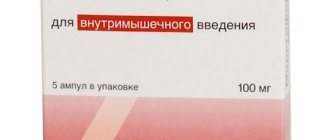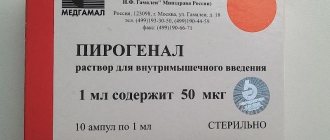Movalis is a non-steroidal anti-inflammatory drug that has a complex effect on all manifestations of inflammation. Gives anti-inflammatory, analgesic and antipyretic effect. The drug relieves unpleasant subjective sensations, and also breaks pathogenetic chains in the development of inflammatory reactions of various origins and localization. The main mechanism of action of meloxicam on inflammatory mediators is inhibition of prostaglandin synthesis.
Release form and composition
The drug Movalis is available in the form of tablets, injection solution and rectal suppositories. Each release form is more effective for certain pathologies.
Movalis tablets 15 mg, 10 or 20 pieces - contain the active ingredient meloxicam in an amount of 15 mg, as well as excipients: lactose monohydrate - 20 mg, sodium citrate dihydrate - 30 mg, MCC (microcrystalline cellulose) - 87.3 mg, povidone K25 - 9 mg, colloidal silicon dioxide - 3 mg, crospovidone - 14 mg, magnesium stearate - 1.7 mg.
Movalis tablets 7.5 mg, 10 pieces - contain the active ingredient meloxicam in an amount of 7.5 mg, as well as excipients: lactose monohydrate - 23.5 mg, sodium citrate dihydrate - 15 mg, MCC (microcrystalline cellulose) - 102 mg, povidone K25 - 10.5 mg, colloidal silicon dioxide - 3.5 mg, crospovidone - 16.3 mg, magnesium stearate - 1.7 mg.
Rectal suppositories Movalis 15 mg, 6 pieces - each suppository contains 15 mg of meloxicam and excipients: Suppocire BP solid fat, polyethoxylated ricin oil, hydrogenated.
Rectal suppositories Movalis 7.5 mg, 6 pieces - contain 7.5 mg of meloxicam and excipients: Suppocire BP solid fat, polyethoxylated ricin oil, hydrogenated.
Movalis injection solution 15 mg/1.5 ml, 3 or 5 ampoules - this release form includes meloxicam 15 mg, as well as excipients: meglumine, poloxamer 188, sodium chloride, sodium hydroxide E524, glycine E640, glycofurol, water for injection, sterile, up to 1.5 ml.
Oral suspension Movalis 7.5 mg/5 ml - 5 ml of the drug contains the active ingredient meloxicam 7.5 mg, as well as excipients: colloidal silicon dioxide - 50.00 mg, hyaetellose - 5.00 mg, sorbitol - 1750 .00 mg, glycerol - 750.00 mg, xylitol - 750.00 mg, sodium dihydrogen phosphate dihydrate - 100.00 mg, sodium saccharinate - 0.50 mg, sodium benzoate - 7.50 mg, citric acid monohydrate - 6.00 mg, raspberry flavor - 10.00 mg, purified water - 2463.50 mg.
Price for Movalis in pharmacies
The approximate price of Movalis in the form of tablets with a dosage of 7.5 mg is 556-680 rubles (pack includes 20 pieces), and with a dosage of 15 mg - 452-573 rubles (pack includes 10 pieces) or 631-795 rubles (pack includes includes 20 pieces). You can purchase a solution for intramuscular injection on average for 571-690 rubles (package includes 3 ampoules) or 789-940 rubles (package includes 5 ampoules). The cost of the oral suspension varies from 462 to 850 rubles. Rectal suppositories are currently not commercially available.
pharmachologic effect
Pharmacodynamics
Movalis contains meloxicam, the main effect of which is the ability to block the synthesis and release of prostaglandins at each stage of their biochemical transformation. The ability to block COX-2, which is one of the main mediators of acute phase inflammation, stands out separately.
The effect of the drug is specific, so COX-1 is not inhibited, which reduces the number of side effects. The highest intensity of exposure is observed at the site of inflammation, and not in peripheral tissues.
It is noted that due to the confirmed high specificity, Movalis does not cause the classic side effect of non-steroidal anti-inflammatory drugs in the form of an effect on platelet aggregation, which avoids an increased risk of bleeding.
Pharmacokinetics
The drug has high bioavailability - 90%, absorption occurs completely in the intestine. The maximum concentration in blood plasma is achieved 5-6 hours after oral administration and 2-3 hours after the injection. Moreover, the bioavailability of injection forms is 100%. Absorption of the drug does not depend on food intake.
Meloxicam quickly passes into a chemically bound form, having a high affinity for proteins, in particular albumins. The binding rate is 99%. Active forms of the drug penetrate into the synovial fluid of the joint capsules, where the concentration is reduced by half compared to blood plasma. With prolonged and systematic use, the concentration in the synovial fluid increases.
The biotransformation of meloxicam occurs mainly in the liver with the participation of cytochromes of the CYP 2C9 and CYP 3A4 families. The toxicity of the drug does not increase during its metabolism; the 4 main metabolites are pharmacologically inactive and are excreted in the urine. Elimination occurs in feces and urine, about 5% of the substance is excreted unchanged.
How many days can you give injections?
In accordance with the instructions, Movalis in the form of injections is prescribed to relieve acute pain. As soon as the patient feels better, the doctor switches him to oral medication - tablets.
How many Movalis injections to give depends on the disease and the degree of its development. The most commonly prescribed treatment regimen involves a 5-day course of injections. But if the patient feels better in a shorter period of time, he will be switched to tablets earlier.
In severe cases, Movalis injections are prescribed for 10-14 days. A longer course is not provided, since the drug is potent and can cause harm to the body with prolonged use.
Indications for use of Movalis
The medicine is used to relieve symptoms of inflammation, including fever, pain, local swelling, and redness. The drug is especially effective in the symptomatic treatment of diseases of the musculoskeletal system, degenerative diseases of the skeleton and muscular system, with causalgic pain and other diseases. The main diseases that are indications for the use of Movalis, as well as dosages to achieve maximum therapeutic effect, are listed below. It is not recommended to exceed the dosage of 15 mg/day. Indications:
- Movalis for osteochondrosis is indicated for use in tablet form at 15 mg/day; with a decrease in symptoms, the dose can be reduced to 7.5 mg/day.
- Movalis for ankylosing spondylitis can be used at a dosage of 15 mg/day orally, but in patients with an increased risk from the cardiovascular system, the therapeutic dose should start at 7.5 mg/day and increase if necessary under the supervision of the attending physician.
- Movalis for neuralgia of any origin can be used symptomatically to relieve pain at a dose of 7.5 mg/day, one tablet once a day.
- Movalis for lower back pain is recommended only when local painkillers are not effective. In this case, a dose of 7.5 mg/day is recommended.
- For pinched nerves, Movalis is indicated for pain relief at a dose of 7.5 mg/day; you can use one tablet or one rectal suppository of 7.5 mg, respectively.
- Movalis for a spinal hernia with progressive pain syndrome, lumbago or lumbar ischialgia, an injection of Movalis 7.5 mg once or 15 mg tablet forms is indicated.
- Movalis for radiculitis is used in doses of 7.5 or 15 mg per day; if this dosage form is not effective, you can use injections of 15 mg once a day. The course of injection treatment should not last more than 3 days with a maximum daily dose of 15 mg.
- Movalis for arthritis, including rheumatoid origin, is used at 15 mg/day, one 15 mg tablet once in the morning or two 7.5 mg tablets in the morning and evening. In the presence of an acute attack of rheumatoid arthritis, injections may be used, but only in cases where tablet forms and suppositories cannot be used or are not effective. Movalis injections are limited to one injection of 15 mg/day.
The justification for using Movalis should be determined by a physician based on the specific pathological condition that can be treated. Dose adjustments are made based on the patient's feedback on how they feel, the reduction of symptoms, or the presence of adverse reactions.
Does Movalis cure a hernia or not?
Any injections or tablets work only after the drug has entered the bloodstream. The original meloxicam, or Movalis, is no exception. It acts on tissue, creating a therapeutic concentration in the blood. On the other hand, all cartilages, including intervertebral discs, do not come into contact with blood. The type of nutrition, or trophism, they have is completely different, just like the optically transparent media of the eye. The vessels will only make it impossible for the cartilage, lens and vitreous body in the eyeball to work.
If the cartilage were intertwined with vessels, then any movement in the joints would be impossible. Vessels and capillaries would rupture, permanent hematomas would form, and as a result of their organization, any movement in the joints would be stopped - ankylosis would occur. Nature has found another mechanism for feeding intervertebral discs and cartilage tissue - this is a diffuse method of assimilation of nutrients from the surrounding synovial fluid by the “whole body” of the cartilage.
Movalis, which gets into the blood, cannot directly affect the hernia, and in general, the cartilage. Let's say more. No drug, including potent corticosteroid hormones, can eliminate protrusion or herniated discs. This can only be done through surgery.
It can be said that any physiotherapeutic procedures, massage, manual therapy, as well as newfangled methods of treatment, such as administering the patient’s own platelet-rich plasma, or PRP therapy, electrical stimulation, and carboxytherapy, also have no effect on the protrusion or hernia.
What then is the effect of Movalis? Why does it help with protrusions and hernias? The fact is that protrusion and hernia have nothing to do with it. This medicine simply relieves acute back pain that originates from the musculoskeletal system, regardless of the exact cause. The thing is that the body’s universal reaction to pain, to compression of soft tissues is inflammation. An elementary callus on the heel, which has formed as a result of prolonged rubbing with a new shoe, is a simple model of protrusion or hernia.
Hernia on MRI.
When moving, the resulting defect in the intervertebral disc gradually irritates, rubs, and compresses the surrounding ligaments, muscle structures and nerve roots. The result is the classic symptoms of inflammation: swelling, increased local temperature, and pain with impaired function. Movalis, as a drug belonging to the class of non-steroidal anti-inflammatory drugs, fully lives up to its name. It removes this inflammatory reaction, reduces swelling and pain. And the hernia, as it was, remains in its place. The body simply stops perceiving this cartilage defect as an extremely strong irritant. How does Movalis achieve its anti-inflammatory effect?
Contraindications
It is not recommended to take meloxicam in patients with developed sensitization to the components of the drug. Contraindicated in patients who have developed symptoms of asthma, swelling, nasal breathing problems or urticaria after taking non-steroidal anti-inflammatory drugs, including derivatives of acetylsalicylic and enolic acids. Taking Movalis is contraindicated:
- During the third trimester of pregnancy, the use of drugs based on meloxicam can lead to impaired blood circulation in the fetus, the development of cardiopulmonary failure, pathology of the urinary system, in particular progressive renal failure. During this same period, the medicine can have a detrimental effect on the course of labor.
- Pathology of the gastrointestinal tract, in the presence of gastric bleeding or perforation of an ulcer, especially if they are caused by the systematic use of a non-steroidal anti-inflammatory drug. A history of gastrointestinal bleeding requires recalculation of the dose and use of other classes of drugs.
- Severe liver failure is a direct contraindication, since the drug undergoes biotransformation with the participation of cytochromes and other liver enzymes. Taking Movalis for functional liver failure can lead to the development of complications.
- Severe renal failure without dialysis. It should be borne in mind that during peritoneal dialysis or hemodialysis the drug can be prescribed with caution, as its elimination will occur.
- Ages under 16 years are a direct contraindication to the use of Movalis due to the peculiarities of biotransformation and distribution of the drug, as well as the development of immediate allergic reactions in this age category. It is impossible to select a safe dose for use in such patients without the risk of adverse reactions.
- Disorders of the blood coagulation system, which are manifested by the presence of bleeding that is difficult to stop, a history of cerebrovascular bleeding and are confirmed by the results of laboratory tests.
- Severe heart failure.
- Simultaneous use of anticoagulants.
Side effects
Side effects are classified depending on the affected organs and systems, as well as by frequency of occurrence in a similar way: very common (1 case out of 10), frequent (1 case out of 100); uncommon (1 in 1000), rare (1 in 10,000), very rare (less than 1 in 10,000), unknown (no exact data on the frequency of occurrence).
From the immune system: infrequently - allergic reactions, urticaria, angioedema, polymorphic rash of allergic origin; unknown - anaphylactic reactions, anaphylactic shock.
From the mental side: rarely - mood swings, nightmares; unknown - disorientation, insomnia.
From the nervous system: often - headache; rarely - dizziness, drowsiness.
From the sensory systems: rarely - ringing in the ears, blurred vision, blurred vision; infrequently - dizziness, conjunctivitis.
From the cardiovascular system: infrequently - increased blood pressure; rarely - palpitations; unknown - heart failure associated with the use of non-steroidal anti-inflammatory drugs.
From the respiratory system: rarely - asthma in patients with allergies to acetylsalicylic acid and other non-steroidal anti-inflammatory drugs; unknown - cough.
From the gastrointestinal tract: often - dyspepsia, nausea, vomiting, abdominal pain, constipation, flatulence, diarrhea; uncommon - gastrointestinal bleeding, stomatitis, gastritis, belching; rarely - colitis, ulcer, esophagitis, abnormal laboratory tests of liver function; very rarely - hepatitis; unknown - liver failure.
From the skin and subcutaneous fat: infrequently - angioedema, itching, rash; rarely - Stevens-Johnson syndrome, toxic epidermal necrolysis, urticaria; very rarely - bullous dermatitis, erythema multiforme; unknown - photosensitivity, exfoliative dermatitis.
From the urinary system: uncommon - sodium and water retention, changes in electrolyte balance (hypokalemia), increased creatinine and/or urea in the blood plasma as a marker of decreased renal function; very rarely - acute renal failure; unknown—impaired urinary frequency.
General disorders and disorders at the injection site: often - hardening and pain at the injection site; infrequently - swelling.
special instructions
When using Movalis, significant skin disorders may develop such as Stevens-Johnson syndrome, toxic epidermal necrolysis and exfoliative dermatitis. Particular attention should be paid to patients with adverse events from the mucous membranes and skin, as well as hypersensitivity reactions to the action of the drug, especially if such reactions were observed during previous courses of treatment. In most cases, skin disorders develop during the first 30 days of using the drug. Sometimes such side effects can cause Movalis to be discontinued.
During treatment, bleeding, perforation and ulcers of the gastrointestinal tract may occur in patients with or without warning symptoms or a history of gastrointestinal diseases. For older patients, the consequences of these complications are more serious.
Patients with gastrointestinal diseases should undergo regular monitoring. If gastrointestinal bleeding or ulcerative lesions of the gastrointestinal tract develop, the use of Movalis should be interrupted.
Treatment with the drug may lead to an increased risk of developing cardiovascular thrombosis, angina attacks, and myocardial infarction (sometimes with death). The risk of such disorders increases with long-term therapy, as well as in patients with a history of the above diseases and in cases of predisposition to their occurrence.
Treatment with Movalis in patients with a reduced circulating blood volume or with reduced renal blood flow may cause the development of decompensation of latent renal failure, since the drug inhibits the synthesis of prostaglandins in the kidneys, which are involved in maintaining renal perfusion. As a rule, after discontinuation of Movalis, functional disorders of the kidneys disappear. Elderly patients are most at risk of developing these reactions; patients with congestive heart failure, dehydration, liver cirrhosis, acute renal impairment or nephrotic syndrome; patients after major surgical interventions that can lead to hypovolemia. In such patients, renal function and diuresis should be carefully monitored at the beginning of therapy. Also, the likelihood of developing latent renal failure increases with simultaneous use with angiotensin II receptor antagonists, diuretics, and angiotensin-converting enzyme inhibitors.
When Movalis is used simultaneously with diuretics, sodium, potassium and water retention may develop, and the natriuretic effect of diuretics may also decrease. Because of this, in predisposed patients, signs of heart failure or hypertension may increase (it is necessary to provide adequate hydration and carefully monitor the condition of such patients).
Periodically during therapy, it is possible to increase the activity of transaminases in the blood serum or other functional indicators of the liver. This increase was in most cases minor and transient. If such disturbances are significant or their severity does not decrease over time, it is necessary to interrupt treatment and further monitor the identified laboratory changes.
Before prescribing Movalis, as well as during combined treatment, it is necessary to conduct a study of the functional state of the kidneys.
Depleted or weakened patients need to be closely monitored as they may be less able to tolerate treatment-related side effects.
It must be borne in mind that Movalis can mask the symptoms of an underlying infectious disease.
The drug may affect fertility, so the use of Movalis is not recommended for women who have difficulty conceiving.
When performing potentially hazardous types of work that require rapid psychomotor reactions and increased concentration (including driving), it is necessary to take into account the possibility of developing visual impairment, dizziness, drowsiness or other disorders of the central nervous system.
Overdose
In case of an overdose of the drug Movalis, no specific manifestations are observed. If the permissible dosage of 15 mg/day is exceeded, the likelihood of developing side effects of meloxicam significantly increases.
The main signs of overdose are general malaise, weakness, nausea, vomiting, pain in the epigastric region, defecation disorders, loss of appetite, sweating, tremor, drowsiness or insomnia, itching, palpitations, tachycardia, increased symptoms of the underlying disease.
Overdose cannot be treated due to the lack of a specific antidote. It is recommended to evacuate gastric contents, take absorbent drugs or prokinetics, drink large amounts of fluid, and stimulate the gag reflex. It is worth considering that the elimination and metabolism of meloxicam can be accelerated by taking cholestyramine.
Interaction
The drug Movalis is capable of interacting with drugs at the pharmaceutical, pharmacokinetic and pharmacodynamic stages. Complex mechanisms of distribution and molecular effects on inflammatory mediators can lead to some unexpected effects that should be taken into account when taking the drug Movalis.
Milgamma and Movalis are used to relieve pain in osteochondrosis and a number of other diseases of the musculoskeletal system and bone tissue. It is not recommended to mix two medications in one syringe; this is fraught with interaction at the pharmaceutical stage and a chemical reaction between the components of the drugs. Injections of drugs should be carried out at different times, with an interval of at least 3 hours, but in general, the use of these drugs in combination has the desired therapeutic effect without dangerous consequences.
Combilipen and Movalis are recommended for use in the treatment of degenerative diseases of the nerve processes of various origins, which are accompanied by pain. B vitamins contained in the drug Combilipen enhance the effect of meloxicam-based drugs and cause an improvement in the patient’s well-being.
Diprospan and Movalis are not recommended for simultaneous use, as this significantly increases the risk of gastrointestinal bleeding and ulcer perforation due to synchronous inhibition of COX 1 and 2 - Diprospan is a glucocorticoid with a strong immunosuppressive effect, which also affects the gastric and intestinal mucosa.
Alflutop and Movalis can be prescribed simultaneously for the treatment of joint diseases, where Alflutop will produce a chondroprotective effect, and Movalis will relieve pain and inflammation. Also, taking them can normalize electrolyte disturbances caused by taking Movalis.
Movalis and Sirdalud, when used simultaneously, reduce each other's effects, being antagonists. Sirdalud is an adrenergic receptor agonist that reduces the effectiveness of non-steroidal anti-inflammatory drugs.
Movalis and Nimesil are contraindicated for simultaneous use due to inhibition of the same chains of prostaglandin synthesis, which increases the risk of complications and a decrease in the coagulant properties of the blood, which can lead to bleeding.
Movalis and Ketonal are contraindicated for simultaneous use, because Ketonal is a non-selective inhibitor of COX 1 and 2, which has a detrimental effect on the mucous membrane of the stomach and intestines, especially with the use of Movalis.
Movalis and Analgin, when used simultaneously, can cause hypothermia and changes in the blood system, in particular agranulocytosis.
Analogues of Movalis
There are many analogues of the drug Movalis in terms of their effect, which can be used to treat the same diseases. However, there are some differences in doses, indications and application features that need to be taken into account.
Which is better: Movalis or Diclofenac?
Diclofenac is in many ways more convenient to use due to the presence of other forms of release, especially gel. This allows Diclofenac to be used topically to relieve symptoms of inflammation. But the bioavailability of Movalis is much higher due to the ability to administer the drug intramuscularly. Movalis also penetrates better into the synovial fluid. When treating diseases of traumatic origin, bruises and injuries, it is recommended to use Diclofenac as a drug with fewer side effects. But in the treatment of rheumatological diseases, Movalis has an advantage.
Which is better: Movalis or Meloxicam?
The active ingredient of Movalis is Meloxicam, so their action is similar at the pharmacodynamics stage, but the pharmacokinetics of the drugs may differ due to the balanced composition of excipients that ensure the structural integrity of Movalis and its rapid accumulation in the blood serum. Elimination of drugs occurs in a similar way. For the most part, the difference between them is only in the release forms and dosage.
Which is better: Movalis or Amelotex?
They also have the same active ingredient - meloxicam. But the bioavailability in the case of Amelotex is several percent lower than that of Movalis, and the maximum dose in the blood serum increases more slowly. The indications and dosages of these drugs are identical. When taking Amelotex, bronchospasm is also possible, which is a rare side effect.
Which is better: Movalis or Arcoxia?
Arcoxia based on etoricoxib is a selective COX 2 inhibitor, which provides reduced side effects compared to non-selective inhibitors. The indications for use of these drugs are similar, but the release forms and dosages differ. Arcoxia also has a more pronounced analgesic effect, which is used to relieve acute postoperative pain syndrome. Etoricoxib in Arcoxia causes fewer side effects than Meloxicam if the permissible daily dosage is exceeded.
Which is better: Movalis or Mydocalm?
Mydocalm is a centrally acting muscle relaxant, which is strikingly different from Movalis in its mechanism of action. Indicated for the treatment of pathologies of the muscular system, while Movalis is more effective for the treatment of pathologies of bone tissue and joints. Also, the bioavailability of Mydocalm is several times lower and amounts to 20%, but the drug can be prescribed to patients with renal failure, because about 90% of metabolism and elimination occurs in the kidneys.
Which is better: Movalis or Nimesil?
Nimesil is more suitable for the treatment of headaches of any origin, pain from bruises and injuries, and reduction of temperature during systemic inflammation. But Nimesil therapy is not effective in the treatment of rheumatic pathology. The action of Nimesil occurs faster, but its elimination proceeds just as quickly.
Which is better: Movalis or Xefocam?
Xefocam is better suited for relieving pain of mild to moderate intensity, while the effect of the drug does not last long, although it begins within a few minutes after administration. Xefocam has a more pronounced analgesic effect than an anti-inflammatory one. Movalis, on the other hand, is a more complex drug that can relieve severe pain and relieve symptoms of inflammation, and with prolonged use it accumulates and the effect of the drug can last quite a long time.
Which is better: Movalis or Voltaren?
Voltaren is a drug based on diclofenac, which is convenient due to its rapid absorption, a wide selection of dosage forms, including for local use in the form of a gel, as well as a pronounced analgesic effect. The range of applications for Voltaren is much wider; it is used to treat surgical, neurological, and gynecological pathologies, while Movalis has a somewhat narrower range of applications.
Which is better: Movalis or Artrosan?
Both drugs are based on meloxicam and have the same doses to achieve the desired therapeutic effect. However, Artrosan can be used from 15 years of age, while Movalis - from 16 years of age.
Which is better: Movalis or Dexalgin?
Dexalgin has a different mechanism of action; it inhibits the conversion of arachidonic acid to thromboxanes and prostaglandins. A noticeable analgesic effect after administration occurs within half an hour and can last up to 6 hours. Dexalgin is also highly effective in the treatment of rheumatic diseases. It can be used to relieve toothache or pain during menstruation, for which Movalis cannot be used.
Which is better: Movalis or Aertal?
Aertal contains aceclofenac, which has a pronounced antipyretic, anti-inflammatory and analgesic effect. Unlike Movalis, Airtal non-selectively inhibits COX 1 and 2, which, when used systematically, can lead to a large number of side effects not characteristic of Movalis, such as bleeding and peptic ulcers.
Which is better: Movalis or Nimesulide?
Nimesulide is developed on the basis of Nimesil and differs only in a large selection of release forms. It is effective for short-term pain relief, but is not able to comprehensively influence the pathogenetic mechanisms that lead to rheumatic damage to organs and systems. The action of Nimesulide is more general and generalized; it can be used to relieve headaches and to achieve an antipyretic effect for colds and acute respiratory viral infections. The action of Movalis is more specific for damage to the musculoskeletal system.
Reviews from patients and opinions of specialists
Doctors prefer Movalis due to its rapid manifestation of analgesic, anti-inflammatory, and anti-exudative effects. The drug is characterized by high clinical efficacy and a low likelihood of developing local and systemic adverse reactions.
Patients appreciated the ability of the drug to eliminate the most severe pain that occurs during exacerbations of pathologies of the joints and spine. Its undoubted advantage is the possibility of one-time use.
Compatibility of Movalis and alcohol
The simultaneous use of Movalis and alcohol is not recommended and may lead to a decrease in the desired therapeutic effect of the drug, the appearance or intensification of side effects and other undesirable consequences. Alcohol is an inhibitor of liver biotransformation enzymes, which are also involved in the metabolism of meloxicam. Because of this, competitive inhibition of cytochrome P450 and its subfamilies is possible, which will lead to increased hepatotoxicity of the drug and ethanol, a decrease in the rate of metabolism and elimination of the drug.
Alcohol's change in the rheological properties of blood, in particular the effect on the surface tension of the liquid fraction and changes in osmotic pressure, can lead to unpredictable pathophysiological effects on the part of the kidneys at the filtration stage. Movalis is excreted by the kidneys, so drinking alcohol may slow down the elimination of metabolites of the active substance from the body.
Data on the mechanisms of interaction between meloxicam and ethanol are incomplete; they may occur at the pharmacokinetic (distribution stage) and pharmacodynamic (final effect stage) stages. The results of such interactions may be unpredictable.
During pregnancy
The use of Movalis during pregnancy, lactation, and breastfeeding is strictly contraindicated. Due to the characteristics of the chemical structure and distribution in biological fluids, the components of the drug penetrate into breast milk.
Since Movalis affects the arachidonic acid cascade, COX and prostaglandins, there is an indirect effect of the drug on fertility. It reduces fertility and may cause delayed ovulation; therefore, the drug is not recommended when preparing for pregnancy. This should be taken into account when taking the medicine to women who are at the stage of planning pregnancy, as well as in the early stages. If you have taken the drug before, it is recommended to discontinue it.
In early pregnancy, prostaglandin synthesis inhibitors statistically significantly increase the chance of miscarriage by 1-1.5%. The risk directly correlates with the dose of the drug and the duration of its use.
There is evidence of the effects of meloxicam on the fetus in the third trimester, which can lead to manifestations of cardiopulmonary toxicity with the development of congenital defects and progressive renal failure in the child.
For the mother's body, meloxicam can be harmful due to the prolongation of contractions and their weakening, which leads to a delay in labor. Possible prolongation of postpartum bleeding time.






